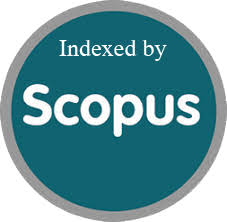Optimal Allocation of Water Resources for the Operation of Multi-Objective Reservoir
Abstract
A multi-objective model was developed to achieve a fair and acceptable allocation of Mosul dam reservoir. The model is aimed to maximize hydropower generation and provide the maximum water irrigation requirements for Al-Jazeera Northern Irrigation Project (ANIP) for three scenarios of reservoir inflow (wet, normal and dry seasons). The optimal results of Pareto front demonstrated the efficiency and success of multi-objective genetic algorithms (MOGA) to achieve fair and acceptable allocation of available water resources in multi-objective reservoirs. In Decision making method, seven distinct points were prepared that depend on the goal of allocating water to the AINP. Using these points, the amount of water allocated for irrigation is gradually increased, and values corresponding to the amount of the hydropower generation goal are found for each scenario. The results of the decision-making process for the seven identified points showed that the balance point can be considered point 7 as it has the possibility of allocating water to irrigate the three stages of ANIP with an increase in hydroelectric power generation for the three seasons by (26.96, 8.42, and 0.22) % respectively. This means that the project can be fully operated even in the dry season. Therefore, those managing persons who are responsible for the water resources of the Mosul Dam must reconsider the water allocation plans currently in place.
References
- Integrated drought risk management DRM national framework for iraq - executive summary - iraq, UNESCO Office for Iraq, ReliefWeb, https://reliefweb.int/report/iraq/integrated-drought-risk-management-drm-national-framework-iraq-executive-summary (accessed Jan. 10, 2024).
- A. Afzal, and K. Y. Kim, "Multi-Objective Optimization of a Passive Micromixer Based on Periodic Variation of Velocity Profile". Chemical Engineering Communications, vol. 202, no. 3, 322331. 2014.DOI:10.1080/00986445.2013.841150
- A. Hatamkhani, A. KhazaiePoul, and A. Moridi, "Sustainable water resource planning at the basin scale with simultaneous goals of agricultural development and wetland conservation". Water Supply Res. Technology-Aqua. vol. 71, pp. 768781. 2022. DOI:10.2166/aqua.2022.025
- A. Konaka, D. W. Coitb, and A. E. Smith ."Multi-objective optimization using genetic algorithms: A tutorial", Reliability Engineering and System Safety, vol. 91, pp 9921007, 2006. DOI:10.1016/j.ress.2005.11.018
- A. M. Younis, T. A. Iwachi, and A. F. Hasan, Future Horizons for Optimal Operation of Mosul Dam Reservoir" Tikrit Journal of Engineering Sciences, vol. 17, no. 4, PP. 16-30, 2010.
- Al-Aqeeli, Yousif H., T. S. Lee, and S. Abd Aziz. Enhanced Genetic Algorithm Optimization Model for a Single Reservoir Operation Based on Hydropower Generation: Case Study of Mosul Reservoir, Northern Iraq. SpringerPlus vol. 5, no. 1, 2016. doi: https://doi.org/10.1186/s40064-016-2372-5
- C. A. C. Coello, G. B. Lamont, D. A. Van Veldhuizen, D. E. Goldberg, and J. R. Koza, "Evolutionary Algorithms for Solving Multi-Objective Problems Second Edition Genetic and Evolutionary Computation Series Series Editors Selected titles from this series" : 2007.
- F. B. Ashraf, H. Huuki, A. T. Haghighi, A. Juutinen, A. romakkaniemi, and H. Marttila, "Valued peaks: sustainable water allocation for small hydropower plants in an era of explicit ecological needs" ESS Open Archive . Nov. 27, 2023. DOI:https://doi.org/10.22541/essoar.170110664.49889080/v1
- H. J. Hammad. "Agricultural Development in The Area of The North Island Irrigation Project - An Applied Study in The Ingredients and Obstacles". Al-Farahidi Etiquette. vol. 15, no. 52, pp.148-173, 2023.
- I. M. Fanuel, A. Mushi, and D. Kajunguri, "Irrigation water allocation optimization using multi-objective evolutionary algorithm (MOEA) a review" Int. J. Simul. Multidisci. Des. Optim. vol. 9, A3 (2018). DOI: https://doi.org/10.1051/smdo/2018001
- K. A. Al-Mohseen ,"Operating Policy of Multi-Purpose Reservoir System Using Goal Attainment Method". IEEE Salahaddin University- Erbil, Iraq, 103, 2011. https://www.researchgate.net/profile/Kamel-Almohseen/publication/323128749
- K. Deb, S. Agrawal, A. Pratap, and T. Meyarivan, A fast elitist non-dominated sorting genetic algorithm for multi-objective optimization: NSGA-II, Lect. Notes Comput. Sci. (including Subser. Lect. Notes Artif. Intell. Lect. Notes Bioinformatics), Springer, Berlin, Heidelberg vol 1917., pp. 849858, 2000. https://doi.org/10.1007/3-540-45356-3_83
- Kang U. et. Al., Compendium of Sand and Dust Storms: A summary for decision-makers. Bonn, Germany, United Nations Convention to Combat Desertification (UNCCD), 2022, https://www.researchgate.net/publication/361436481
- L. Deng, S. Guo, J.Yin, Y. Zeng, and K.Chen, "Multi-objective optimization of water resources allocation in Han River basin (China) integrating efficiency, equity and sustainability" Scientific Reports vol. 12, no. 798, 2022.DOI: https://doi.org/10.1038/s41598-021-04734-2
- Loucks, Daniel P., et al. Water Resource Systems Planning and Management an Introduction to Methods, Models, and Applications. Springer International Publishing, 2017.
- M. A. Khattab, and K. A. Al-Mohseen, "Planning and decision making under uncertainty (Mosul reservoir optimal operating policy-case study)". Al-Rafidain Engineering Journal (AREJ), vol. 25, no. 1, pp. 8596, 2020.
- M. A. Khattab, and K.Almohseen, "Surrogate Worth Trade-Off (SWT) Method and the Decision-Making Process in Water Resources Planning and Management". Al-Rafidain Engineering Journal (AREJ), vol. 25, no. 2, pp. 118-126, 2020. doi: https://doi.org/10.33899/rengj.2020.127592.1049
- M. Imran, N. A. Pambudi, and M. Farooq. "Thermal and hydraulic optimization of plate heat exchanger using multi objective genetic algorithm". Case Studies in Thermal Engineering, vol. 10, pp. 570578. 2017. DOI:10.1016/j.csite.2017.10.003
- M. J. Reddy and D. N. Kumar."Optimal Reservoir Operation Using Multi-Objective Evolutionary Algorithm". Water Resources Management". vol. 20, pp. 861878, 2006. DOI: 10.1007/s11269-005-9011-1
- M. Kazemi, O. Bozorg-Haddad, E. Fallah-Mehdipour, and X. Chu, "Optimal water resources allocation in transboundary river basins according to hydropolitical consideration. Environment", Development and Sustainability. Vol.24, pp. 11881206 2022. DOI:10.1007/s10668-021-01491-0
- M. Solgi, O. Bozorg-Haddad, and A. H. Loiciga. " multi-objective optimization model for operation of intermittent water distribution networks". Water Supply, vol. 20, no. 7, 26302647. 2020. doi: 10.33899/rengj.2020.127592.1049
- M. Wanga, Y. Zhang, Y. Lu, X. Wand, B. Xud, and L.Yuc, "Comparison of multi-objective genetic algorithms for optimization of cascade reservoir systems".Water and Climate Change. vol. 13, no. 11, pp. 40694086, 2022. DOI: 10.2166/wcc.2022.290
- MATLAB (2023a). The Language of Technical Computing, The MathWorks, Inc., MA, USA. https://www.mathworks.com/.
- O. M. A. Mahmood Agha and M. A. Khattab," The impact of Ilisu Dam on water flow toward Iraq and identifying the optimal operational strategy for Mosul Dam ", Sustainable Water Resources Management, vol. 9, no. 112, 2023. DOI: https://doi.org/10.1007/s40899-023-00889-0.
- O. Pao-Yu and M. Siehlow,"WATER-Model An Optimal Allocation of Water Resources in Turkey, Syria and Iraq". DIW Berlin, 2014. https://www.diw.de/de/diw_01.c.465173.de/publikationen/diskussionspapiere/2014_1381/water-model__an_optimal_allocation_of_water_resources_in_turkey__syria_and_iraq.html
- S. C. Cerda-Flores, A. A. Rojas-Punzo, and F. Npoles-Rivera , "Applications of Multi-Objective Optimization to Industrial Processes: A Literature Review". Processes 2022, vol. 10, no. 133. 2022. DOI: https://doi.org/10.3390/pr10010133
- S. Naghdi, O. Bozorg-Haddad, M. Khorsandi, and X. Chu. "Multi-objective optimization for allocation of surface water and groundwater resources" Science of the Total Environment, vol. 776, pp. 146026, 2021. DOI: https://doi.org/10.1016/j.scitotenv.2021.146026
- S. Sissakian, and N. Adamo, N. Al-Ansari, "The role of geological investigations for dam siting: Mosul Dam a case study". Sissakian, V.K., Adamo, N. & Al-Ansari, N. The Role of Geological Investigations for Dam Siting: Mosul Dam a Case Study. Geotech Geol Eng Vol. 38, pp. 20852096 (2020). https://doi.org/10.1007/s10706-019-01150-2
- Sh. Zhang, G. Fang, D. Zhang, M. Ju1 and H. Zhong, "Water resources optimal allocation model for coordinating regional multi-level water resources managers interests". Front. Environ. Sci. vol. 11. pp. 1152296. 2023.DOI:10.3389/fenvs.2023.1152296
- X. Tang, Y. He, P. Qi, Z. Chang, M. Jiang and Z. Dai, "A New Multi-Objective Optimization Model of Water Resources Considering Fairness and Water Shortage Risk". Water, vol. 13, pp. 2648. 2021. https://doi.org/10.3390/w13192648
- Y. Lu, L. Ganb, Y. Chena, and N. Zhenga, "Research on the allocation of water resources engineering projects based on multiobjective optimization", Water Supply Vol. 23 No. 8, pp. 3297, 2023. DOI:10.2166/ws.2023.153
- Z. Dong, J. Zhang, K. Zhang, X. Wang and T. Chen, "Multi-objective optimal water resources allocation in the middle and upper reaches of the Huaihe River Basin (China) based on equilibrium theory"Scientific Reports, vol. 12, pp 6606 , 2022.DOI: https://doi.org/10.1038/s41598-022-10599-w
- Z. Yan, Z. Zhou, J. Liu, T. Wen, X. Sang, and F. Zhang, "Multiobjective Optimal Operation of Reservoirs Based on Water Supply, Power Generation, and River Ecosystem with a New Water Resource Allocation Model". Journal of Water Resources Planning and Management, vol. 146, no.12, pp. 05020024-1-05020024-11. 2020. DOI:10.1061/(asce)wr.1943-5452.0001302








